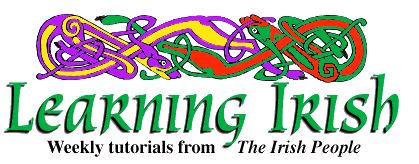
Irish Lesson 2
|
You are now ready to make a classic entry into the Irish language, by way of an important verb: Tá (taw*). "Tá" serves to tell where something is or what its condition is, and therefore it has some of the functions of English "is". For the (t) sound next to an "a", "o" or "u", put the front part of your tongue up along the top of your mouth, with the tip against the upper front teeth and almost--but not quite--protruding between the teeth. Pronounce the (t) sound a few times. If you extend the tongue too far between the teeth, you will say English "th" as in "that" or "throw". Irish does not have those sounds. For the (aw*) sound, say the English word "tot", but start the word with the Irish (t) you have just learned. Repeat several times, then drop the final "t" and lengthen the (aw*) sound. As a check, try making the (aw*) sound in another way: Say English "awful" several times slowly, and notice that your lips are pushed far out. Try the word with your lips held in closer and more rounded. You may recognize the sound as the way some Irish pronounce "awful". Now learn these words, referring back to the Lesson 1 pronunciation guide as necessary:
Tá sé (TAW* shay*) he is, it is Next, learn these sentences, then translate them. Form a mental picture each time. Tá sé fuar. Tá mé mór. Tá sí óg. Tá sé lán. Tá sé te. Tá sí sean. Learn these new words thoroughly:
fear (far) man, a man We can substitute these into the basic sentence "Tá sé fuar", he is cold, to make new sentences: Tá fear anseo (taw* FAR un-SHUH). A man is here. Tá Seán anseo (taw* SHAW*N un-SHUH). John is here. Tá bean agus fear ansin (taw* BAN AH-guhs FAR un-SHIN). A women and a man are there. Tá Bríd láidir (taw* BREED LAW*-dir). Bridget is strong. "Tá" is irregular, one of only ten or eleven Irish verbs that are. For the negative of "tá", the basic word is "níl" (neel).
Read these: Níl mé fuar (NEEL may* FOO-uhr). I am not cold. Níl Seán ramhar (NEEL shaw*n ROU-wuhr). John is not fat. For questioning with "tá", the basic group is "an bhfuil" (un VWIL). In the West of Ireland this may be pronounced (un WIL). Read these: An bhfuil fear ansin? (un vwil FAR un-SHIN) Is a man there? An bhfuil Nóra óg? (un vwil NOH-ruh ohg) Is Nora young? An bhfuil bosca anseo? (un vwil BOHSK-uh un-SHUN) Is there a box here?
Pronunciation You learned how to pronounce broad "t" above, in the word "tá". Pronounce a broad "d" with the front part of the tongue in the same position, along the roof of the mouth, with the tongue tip almost protruding between the teeth. Try: dá (daw*), dó (doh), dún (doon), drom (drohm), dlú (dloo), dath (dah). For slender "d" and "t", place the tongue tip, and only the tip, on the hard ridge just behind your upper front teeth. Then pronounce the "t " or "d". (In the West there is a tendency to pronounce these by sliding the tongue off the ridge, giving sounds closer to ch or j). Practice on these: deil (del), déan(day*n), dílis (DEE-lish), ding (ding), deacair (DAK-uhr), dlí (dlee), te (te), téann (TAY*-uhn), timire (TEEM-i-re), teas (tas).
Conversation Do not try to understand the grammar of the words or phrases yet. Pay special attention to "duit". This is generally pronounced with a (g) sound at the start, and we will do that in this lesson. The letter "u" in the word merely tells you that the "d" or "g" gets its broad sound. The "t" must get a slender sound. Séamas: (SHAY*-muhs): Dia duit, a Nóra (DEE-uh git, uh NOH-ruh). Hello, Nora. Nóra: Dia's Muire duit, a Shéamais (DEE-uhs MWIR-uh git, uh HAY*-mish). Hello James. Séamas: Conas tá tú? (KUN-uhs TAW*too). How are you? Nóra: Tá mé go maith, agus conas tá tú féin? (TAW* may* goh MAH, AH-guhs KUN-uhs TAW* too fay*n). I am well, and how are you? Séamas: Tá mé go maith, leis. (TAW*may* goh MAH, lesh). I am well, too. (c) 1997 The Irish People. May be reprinted with credit. |